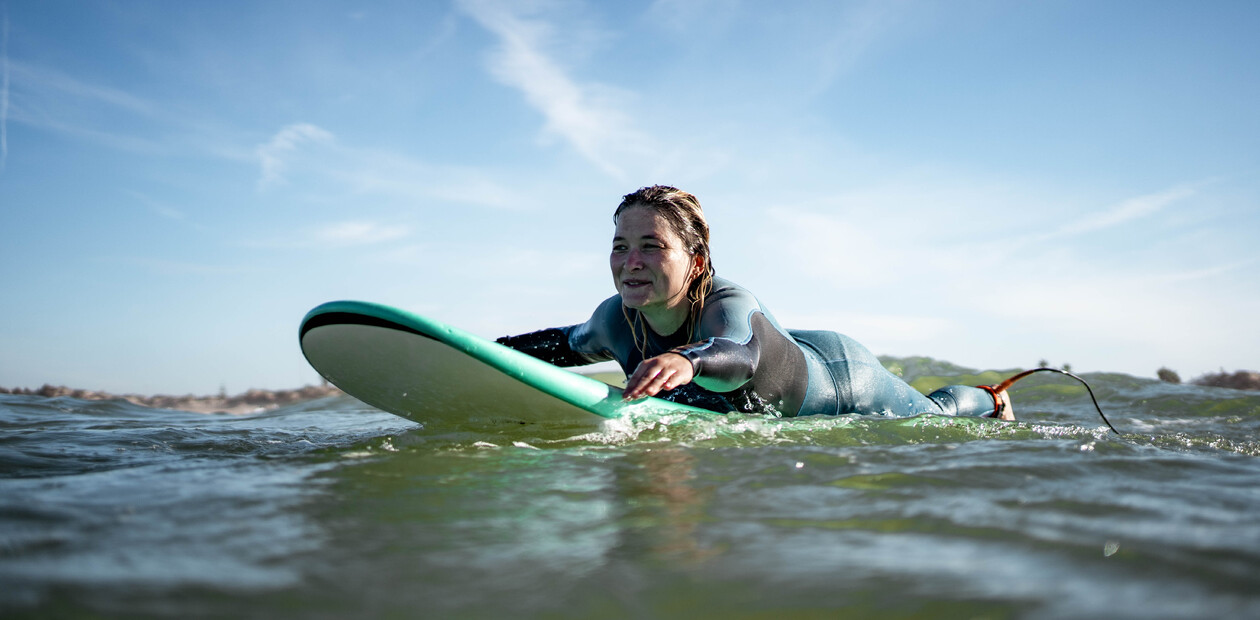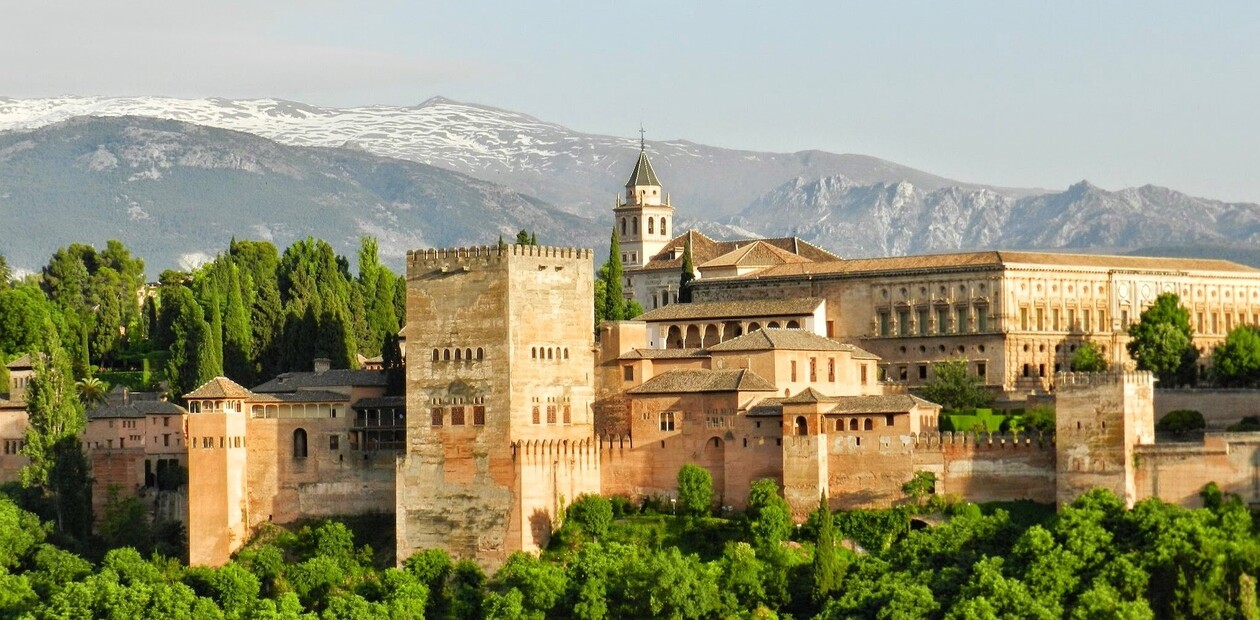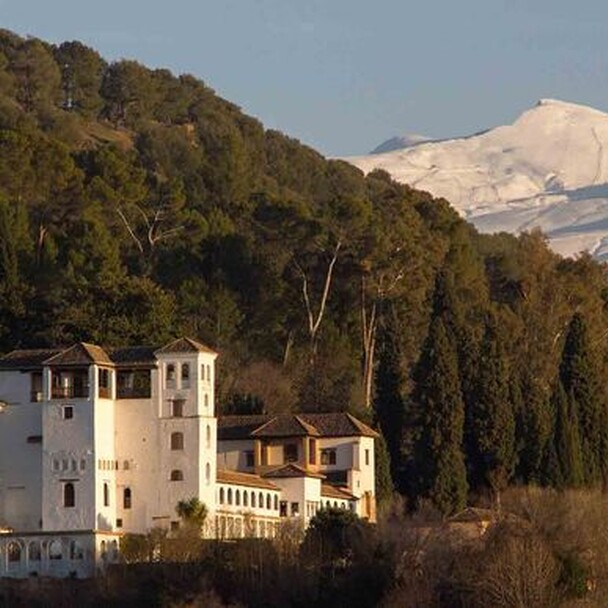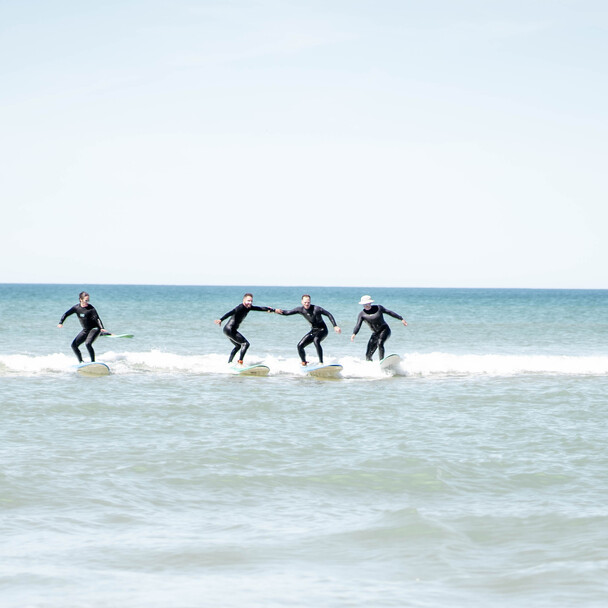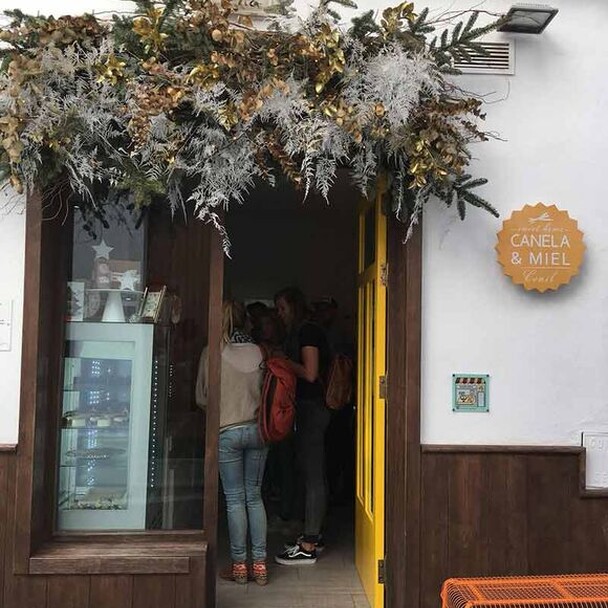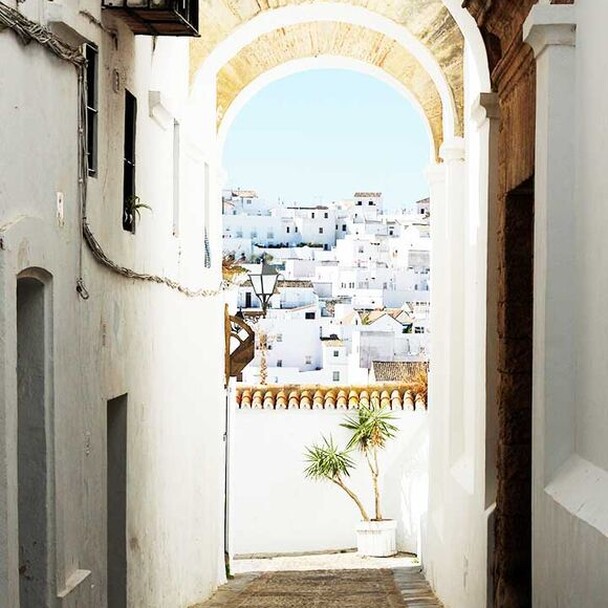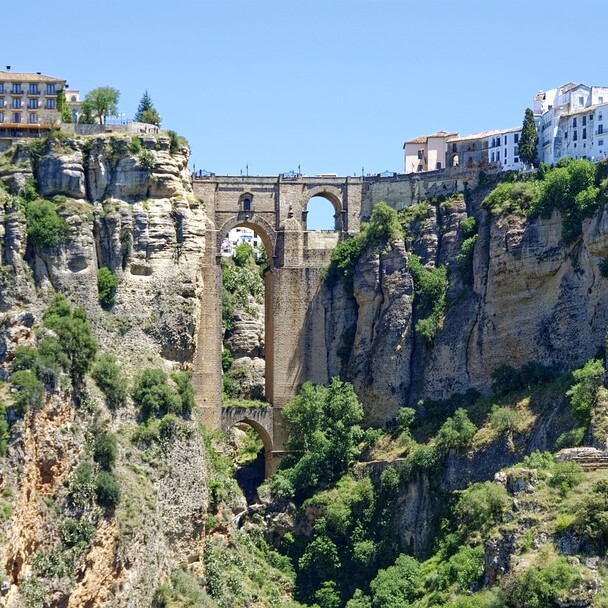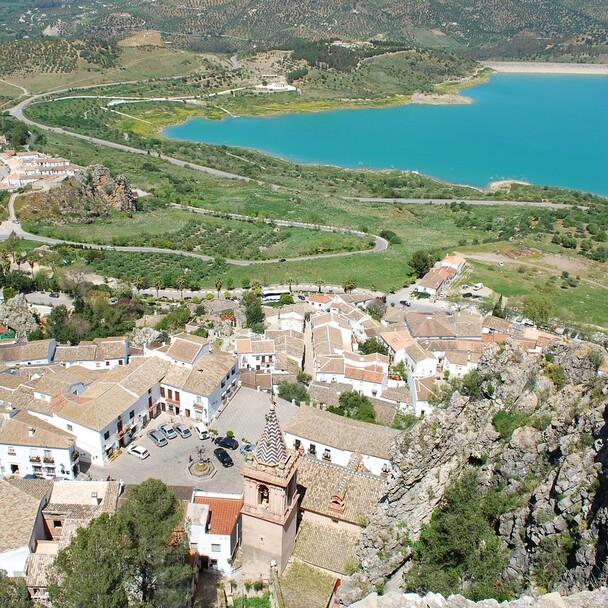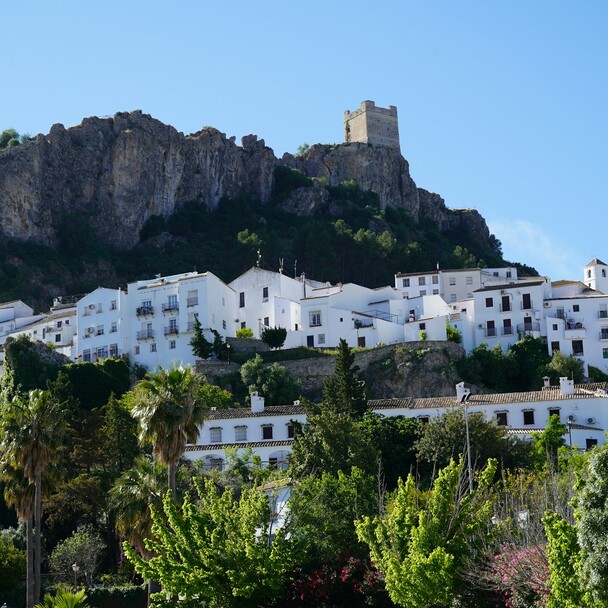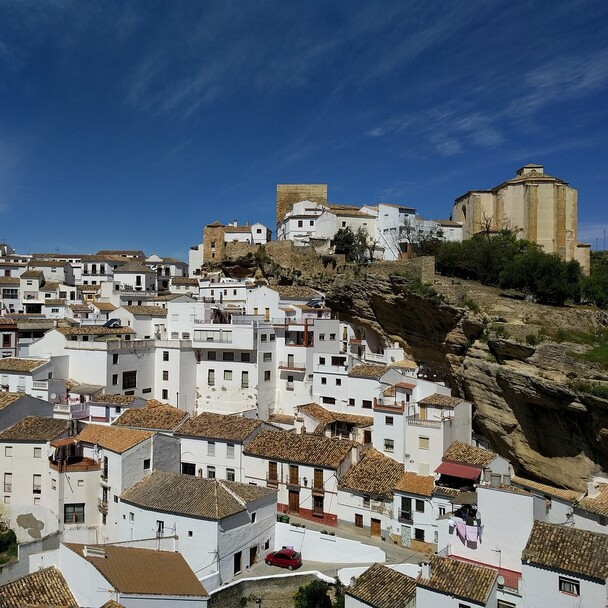Sightseeing and surfing in Andalusia
- Introduction
- The cultural and scenic diversity of Andalusia
- Importance of Andalusia as a destination for culture, nature and active vacations
- Surfing in El Palmar
- Why El Palmar is an insider tip for surfers
- Surf camp in El Palmar
- Surfing conditions and best seasons
- The best surf spots in Andalusia
- Local culture: chiringuitos and beach life away from the waves
- What else you can do in Andalusia besides surfing
- Yoga classes in El Palmar
- Natural paradises and beaches
- Doñana National Park
- Sierra Nevada
- The best beaches on the Costa de la Luz
- The most beautiful beaches on the Costa del Sol
- Top cities in Andalusia
- Seville
- Marbella - Admire the yachts of the rich and famous
- Malaga
- Gibraltar - Monkey watching in Great Britain?
- Tarifa - drinking coffee at the southernmost point of Europe
- Cádiz - Cuban flair meets James Bond
- Córdoba
- Granada
- Granada tip: The Alhambra
- The White Villages: Charming jewels in Andalusia
- Conil de la Frontera
- Vejer de la Frontera
- Restaurant tip near Vejer
- Ronda
- Zahara de la Sierra
- Setenil de las Bodegas
- Cultural highlights off the beaten track
- Festivals and traditions
- Historic places and ruins
- Unknown sights
- Andalusian gastronomy: culinary highlights
- Typical dishes: tapas, gazpacho and pescaito frito
- Wine tours in Jerez: Sherry and its tradition
- Special restaurants and markets in Seville, Málaga and Cádiz
- Practical travel tips for Andalusia
- Best time to travel to Andalusia
- Transportation options: Car, train and bus
- Conclusion
Introduction
Andalusia, the southernmost region of Spain, enchants visitors with an extraordinary blend of culture, history and breathtaking landscapes. This region is not only the gateway to Africa, but also a melting pot of cultures, where Arab, Jewish and Christian influences merge together. The diversity of Andalusia is reflected in its magnificent palaces, historic towns and picturesque villages. But not only culture and history lovers will get their money's worth here - nature lovers, beach holidaymakers and active vacationers will also find their paradise in Andalusia.
The cultural and scenic diversity of Andalusia
From the impressive Moorish buildings in Granada and Seville to the white villages in the mountains and the pristine beaches on the Costa de la Luz - Andalusia offers an impressive range of experiences. Each town and village tells its own story, shaped by centuries of changing rulers and cultures. The landscapes range from the snow-capped peaks of the Sierra Nevada to the vast plains and olive groves that characterize the rural image of Andalusia.
Importance of Andalusia as a destination for culture, nature and active vacations
Andalusia is more than just a travel destination - it is an experience for the senses. Here you can immerse yourself in Spain's eventful history, which comes to life in the winding streets of Córdoba or the magnificent palaces of Seville. Nature lovers will be delighted by the diverse landscapes, which range from the arid desert landscapes of the Tabernas to the fertile valleys and coasts. For active vacationers, the coasts of Andalusia offer perfect conditions for water sports such as surfing and kitesurfing, while the mountains offer numerous hiking and climbing opportunities.
Surfing in El Palmar
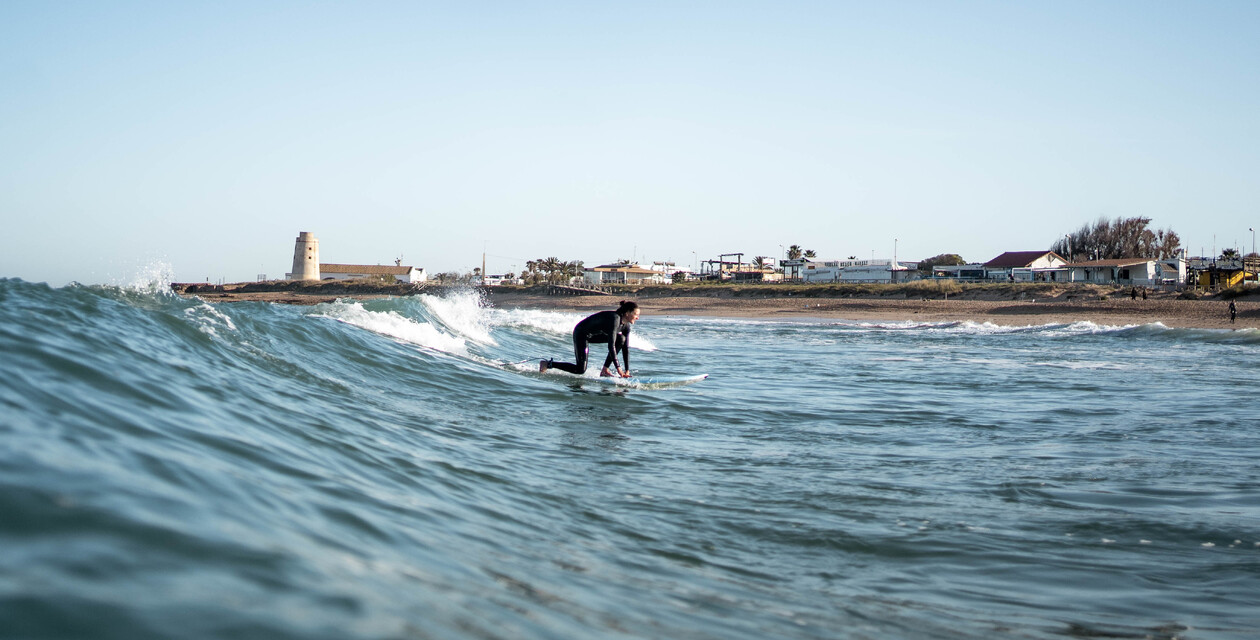
Why El Palmar is an insider tip for surfers
Playa El Palmar on the Costa de la Luz is no longer an insider tip among surfers, but it has retained its authentic charm. While many of the well-known surf spots in Spain are overcrowded, El Palmar offers a relaxed atmosphere and unspoiled nature that attracts both beginners and experienced surfers. The long, fine sandy beach stretches for several kilometers, so there is enough space for everyone, even in high season. Unlike many other surf hotspots, El Palmar is not characterized by large hotel complexes and crowds of tourists, but remains a place where the connection to nature and the surfing lifestyle are paramount.
Surf camp in El Palmar
If you come to El Palmar to surf, it's best to stay in a surf camp. Then you'll be well looked after and won't have to worry about a thing. At the A-Frame surf camp, you stay in beautiful accommodation by the sea. You can take a surf course, take part in a yoga class and enjoy the sun. You will also be well catered for in culinary terms, as all meals are included at A-Frame. The day gets off to a great start with a delicious breakfast. At lunchtime you get a nutritious lunch with dessert and the highlight comes in the evening: a fantastic three-course dinner. You can watch the sun set over the sea, listen to the sound of the waves and make new friends with the guests.

Surfing conditions and best seasons
El Palmar offers good surfing conditions all year round, making it an attractive destination for surfers. The waves here are particularly consistent and offer a wide range of levels. In summer, the waves tend to be smaller and it is usually flat. The beach is full of tourists. Therefore, El Palmar is more attractive from fall through winter until June. Autumn and winter bring bigger, more powerful waves that challenge even experienced surfers. The best time for advanced surfers is from October to March, when the storms in the Atlantic build up the waves and the temperatures are still pleasant. Thanks to the mild climate, you can also surf here in winter without any problems. There is always a wave for beginners too.
The best surf spots in Andalusia
Andalusia is a paradise for surfers, attracting both beginners and experienced surfers. With its coastline along the Atlantic Ocean and the Mediterranean Sea (with less surfing here), the region offers an impressive variety of beaches with different conditions. Here are some of the best surf spots in Andalusia:
1. El Palmar (Costa de la Luz)
El Palmar is probably the most famous surf spot in Andalusia and an absolute highlight for surfers. The beach offers consistently good conditions and is known for its powerful Atlantic waves, especially in spring, fall and winter. In summer, the waves tend to be smaller or non-existent, and the beach is also absolutely overcrowded with holidaymakers. It is therefore best to avoid the height of summer (July/August). The relaxed atmosphere and the large number of surf schools make El Palmar an ideal place to learn to surf or refine your technique.
2. Tarifa
Known as the "capital of the wind", Tarifa is a world-famous destination for water sports enthusiasts. In addition to kitesurfing and windsurfing, Tarifa also offers good surfing conditions, especially on the beach of Playa Los Lances. The consistent waves and the lively vibe of the city attract surfers from all over the world. Tarifa is ideal for anyone who wants to combine surfing with a lively, international surf scene. We're not talking about surfing here, but kitesurfing and windsurfing.
3. Cádiz and the surrounding area
The beaches in and around Cádiz, such as Playa de la Cortadura and Playa de Santa María del Mar, are also popular destinations for surfers. Conditions here are particularly good in the fall and winter. These beaches are known for their relaxed atmosphere and the mix of gentle and challenging waves that suit both beginners and advanced surfers.
4. Playa de Mazagón (Huelva)
Further west on the Costa de la Luz is Playa de Mazagón, a beach that is particularly characterized by its long waves and calm surroundings. This is a great spot for surfers who want to escape the hustle and bustle and enjoy the waves in a natural setting.
5th Playa de Los Caños de Meca
Los Caños de Meca offers three surf spots, two of which are particularly suitable for longboards. The third surf spot is located in front of a row of white houses, which is why it is called Apartamentos. This one is more suitable for advanced surfers and is often reserved for locals. The beach is surrounded by dunes and pine forests, which creates a special atmosphere.
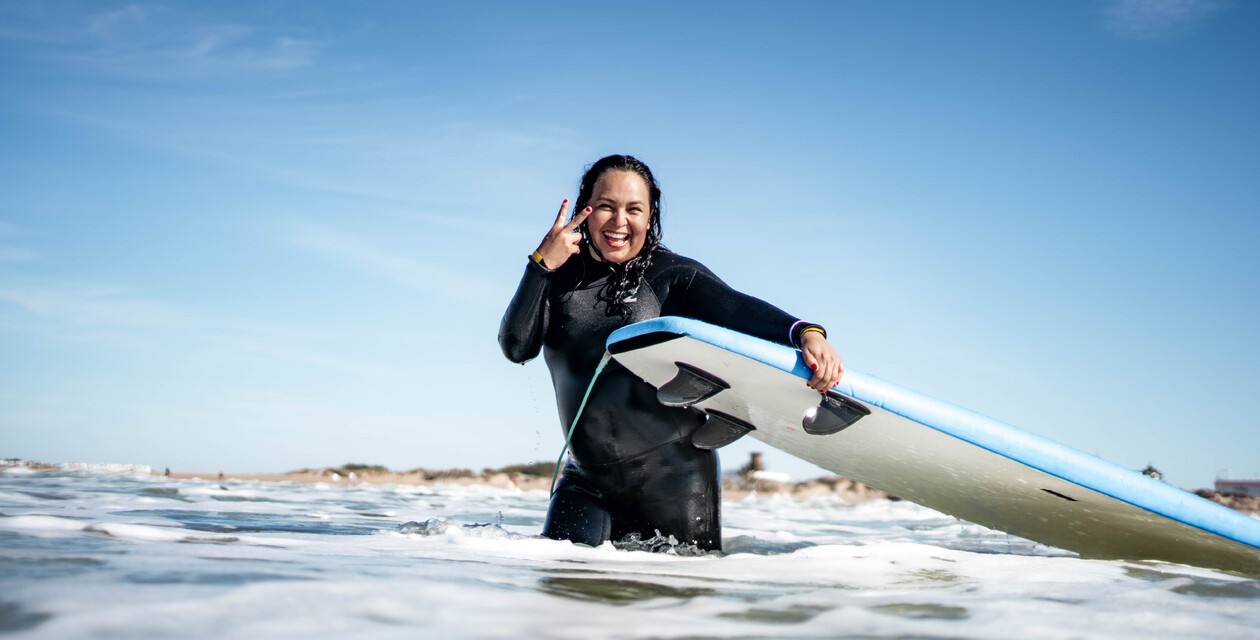
Local culture: chiringuitos and beach life away from the waves
El Palmar is not only a paradise for surfers, but also a place where you can enjoy the relaxed beach culture of Andalusia to the full. The small bars along the beach offer a perfect mix of local cuisine, fresh seafood and refreshing drinks. After a day on the water, you can end the evening here with live music, tapas and a view of the sunset. Away from the waves, beach life in El Palmar is characterized by a lively yet relaxed atmosphere that invites visitors to unwind and enjoy the simple life on the beach. The local community is open and welcoming, which makes a stay here particularly pleasant. There is little going on here in winter, which is particularly appealing to those looking for peace and relaxation. Or surfers who want a relaxed surfing experience. At this time of year, not all bars and restaurants are open. But the relaxed Vibe is still there. :-)
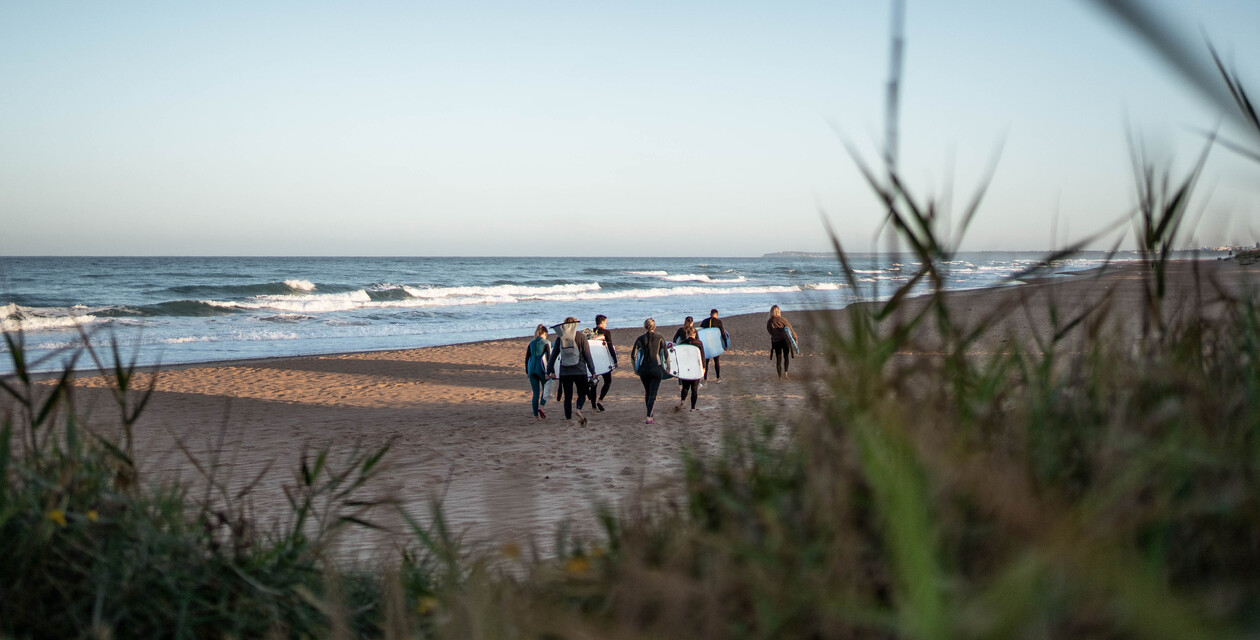
What else you can do in Andalusia besides surfing
If you come to Andalusia to surf, you won't just find excellent waves here. Hardly any other place is as packed with culture and outdoor opportunities as Andalusia. Here you can go hiking, mountain biking or climbing. Or you can explore beautiful cities such as Seville, Cádiz, Tarifa, Málaga, Córdoba or Granada. The Alhambra is famous worldwide, as is the Sierra Nevada. There are also lesser-known, but no less impressive gems, which we will reveal to you now.

Yoga classes in El Palmar
In our own A-Frame yoga house, we offer open yoga classes for our guests almost every day. Here you can breathe in the scent of wood and the sea, listen to the chirping of the birds and the sound of the waves and come back to yourself.
You can also book a whole week of yoga at our camp. These yoga retreats each offer a different focus. There is the A-Frame Yoga Retreat, our Yoga & Surf Retreat, a Pottery & Yoga Retreat, the Be You Selflove Retreat and many more.
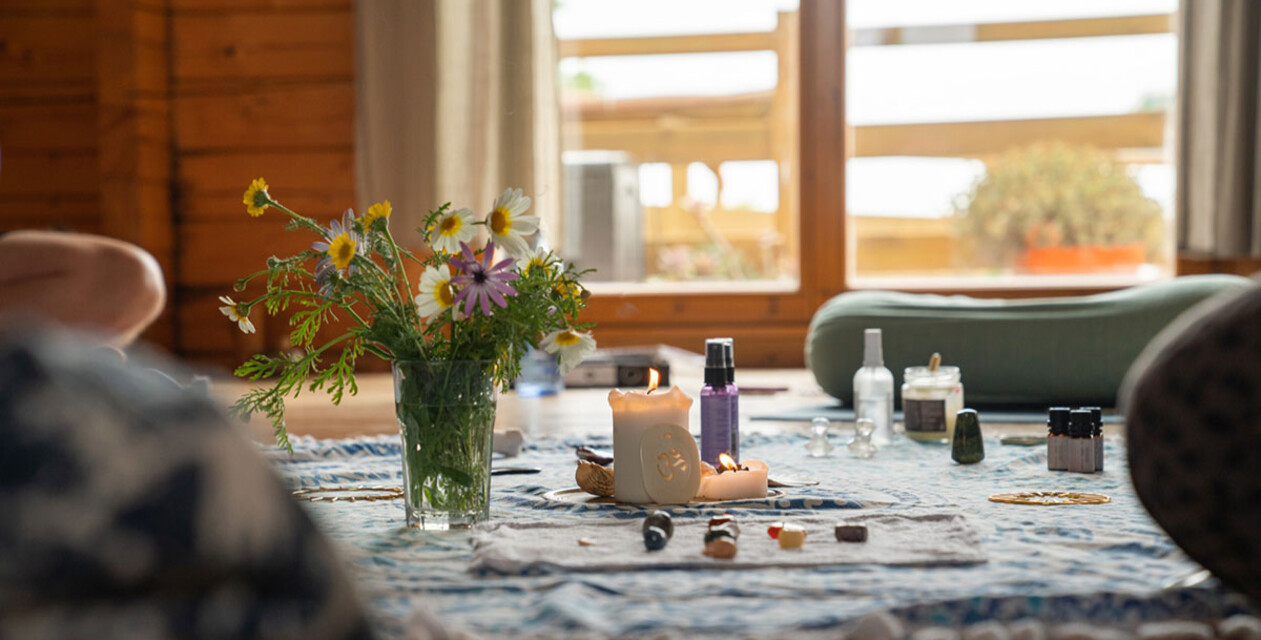
Natural paradises and beaches
Andalusia is not only known for its cultural treasures, but also for its impressive natural paradises and beautiful beaches. From the vast plains and dunes of the Doñana National Park to the snow-capped peaks of the Sierra Nevada and the pristine beaches of the Costa de la Luz, this region offers a fascinating variety of landscapes that will delight any nature and beach lover. Here are some of the most outstanding natural paradises and beaches in Andalusia.
Doñana National Park
Hiking, cycling and birdwatching in Doñana National Park
Welcome to Spain's most important wetland area in Europe. The huge Guadalquivir river delta consists of numerous lagoons, water streams, wildlife reserves and pine forests, riverbanks, dunes, beaches and impressive cliffs. Millions of migratory birds stop here every year, making Doñana one of the most important nature reserves in the world. You can discover this nature reserve. Either on a hike or by bike. There are also boat trips. If you would like to go bird watching, you can do so with or without a guide. In any case, the offer for bird lovers is more than excellent.
Sierra Nevada
In der Sierra Nevada kannst du im Sommer Wandern und im Winter Ski fahren. Die Sierra Nevada liegt im so genannten Sistema Penibético, in der Nähe von Granada. Die Lifte der Sierra Nevada bringen dich mal schnell von 2100 bis auf 3282 Meter hinauf.
Wandern und Wintersportmöglichkeiten
Die Sierra Nevada ist das höchste Gebirge der Iberischen Halbinsel und bietet eine beeindruckende Vielfalt an Outdoor-Aktivitäten, die das ganze Jahr über möglich sind. Während die schneebedeckten Gipfel im Winter ein Paradies für Skifahrer und Snowboarder darstellen, verwandelt sich die Region im Sommer in ein Wanderparadies. Zahlreiche gut markierte Wanderwege führen durch die spektakulären Landschaften, vorbei an Bergseen, Wasserfällen und tiefen Tälern. Der Mulhacén, der höchste Gipfel Spaniens außerhalb der Pyrenäen, bietet erfahrenen Wanderern eine besondere Herausforderung und einen atemberaubenden Ausblick.
Traditionelle Bergdörfer wie Trevélez
Inmitten der Sierra Nevada liegen einige der höchstgelegenen Dörfer Spaniens, darunter das malerische Trevélez. Dieses Dorf ist nicht nur für seine traditionelle Architektur und seine herrliche Lage bekannt, sondern auch für seinen exzellenten Serrano-Schinken, der in der reinen Bergluft getrocknet wird. Ein Besuch in Trevélez bietet die Möglichkeit, das authentische Leben in einem andalusischen Bergdorf zu erleben und die regionale Küche zu genießen. Die verwinkelten Gassen, die weiß getünchten Häuser und die beeindruckende Bergkulisse machen Trevélez zu einem unvergesslichen Ziel.
The best beaches on the Costa de la Luz
The beaches of the Costa de la Luz are known for their naturalness and good waves.
Playa de Bolonia: Roman ruins and pure nature
The Playa de Bolonia on the Costa de la Luz is a real insider tip for beach lovers and history buffs. This pristine beach is located near Tarifa and impresses with its fine, white sand and crystal-clear water. A particular highlight are the Roman ruins of Baelo Claudia, which are located directly on the beach and offer a fascinating insight into life in an ancient trading town. The combination of culture and nature makes Playa de Bolonia a unique place where visitors can both relax and experience history up close.
Playa de la Barrosa: Family-friendly beach with promenade
Playa de la Barrosa in Chiclana de la Frontera is one of the best-known and most popular beaches on the Costa de la Luz. This spacious, family-friendly beach offers everything you need for a perfect day at the beach: fine sand, gentle waves and a beautiful promenade with numerous restaurants, cafés and stores. Playa de la Barrosa has been awarded the Blue Flag several times, confirming the high quality of the water and facilities. Visitors can not only swim and sunbathe here, but also try out numerous water sports such as windsurfing and kitesurfing.
Playa El Palmar: a paradise for surfers and nature lovers
Playa El Palmar is one of the most beautiful and unspoiled beaches on the Costa de la Luz. It is located near Vejer de la Frontera and is known for its wide, fine sandy beach that stretches for several kilometers along the coast. El Palmar has retained the charm of an unspoiled beach and is free from large hotel complexes or crowded promenades. Instead, visitors will find a relaxed and authentic atmosphere that is perfect for anyone looking to escape mass tourism.
Surfing and water sports
Playa El Palmar is particularly popular with surfers, as the Atlantic waves here offer excellent conditions all year round. Whether beginner or advanced - the gentle waves in summer and the stronger waves in winter make El Palmar an ideal spot for surfers of all levels. There are several surf schools and rental stations on site that offer both surfing lessons and equipment. Other water sports such as kitesurfing and stand-up paddling are also possible here, making the beach a versatile destination for active holidaymakers.
The most beautiful beaches on the Costa del Sol
If you pass by the Costa del Sol on your Andalusia round trip, we recommend one of these beaches:
Playa de Burriana in Nerja - Be sure to try the paella at Restaurante Ayo
Playa de Maro, Nerja - For many, this is the most beautiful beach on the Costa del Sol. Crystal-clear, turquoise water and an idyllic landscape. Great for snorkeling or kayaking.
Playa Malapesquera, one of the most popular beaches in Benalmádena. There is a lot going on here: kayaks, SUPs, restaurants, toilets & showers
Playa de Artola- Cabopino in Marbella - Perfect for families as the water quality is high
Playa de Carvajal in Fuengirola
Playa de la Carihuela, Torremolinos - Ideal for families and couples as the water is calm and shallow. Great beach promenade for cycling or walking.a
La Rada, Estepona - Here flies the Blue Flag, a sign of the best water quality and purity. There is a playground, pedal boat hire and trampolines for children.
Playa Las Viborillas, Benalmádena - This beach is unknown, somewhat secluded and resembles a tropical paradise
Torre del Mar, Vélez Málaga - Family atmosphere, restaurants and various water sports
El Faro, Marbella - Busy beach close to luxury stores and the Parque de la Constitución. Free parking!
El Padrón, Estepona - Popular beach with showers, toilets and water sports hire. Lush vegetation and biodiverse underwater world.
Bounty Beach, Marbella - Especially popular with young people. Chill-out music, beach bars, relaxed atmosphere.
Top cities in Andalusia
Andalusia is known for its impressive cities, which impress with their unique blend of history, culture and breathtaking architecture. Each city tells its own story and offers a multitude of sights that are deeply rooted in the region's turbulent past. Here are the three most important cities in Andalusia that no visitor should miss: Seville, Granada and Córdoba. But Cádiz, Marbella, Málaga and Tarifa also have their own special charm.

Seville
Sevilla is the capital of Andalusia and is located in the interior of the country. Seville is particularly popular with young people. In addition to the many historical sights, the nightlife here is also lively. Those who prefer culture should definitely visit the famous Plaza de España. This impressive square was the setting for the classic film Star Wars: Episode 2 The Alcazár Gardens are a wonderful place to relax. This beautiful park is part of the famous royal palace, the Alcázar of Seville, and is located directly on the Avenida de Menéndez Pelayo. If you are in the city center, you can easily walk there. Incidentally, the Alcázar is a UNESCO World Heritage Site.
Tip: Surf teacher Pako comes from Seville and knows where to get the best tapas in the city. HE recommends the Bodega Santa Cruz in Calle Rodrigo Caro, 1A, and the Restaurante Gonzalo in Calle Alemanes, 21.
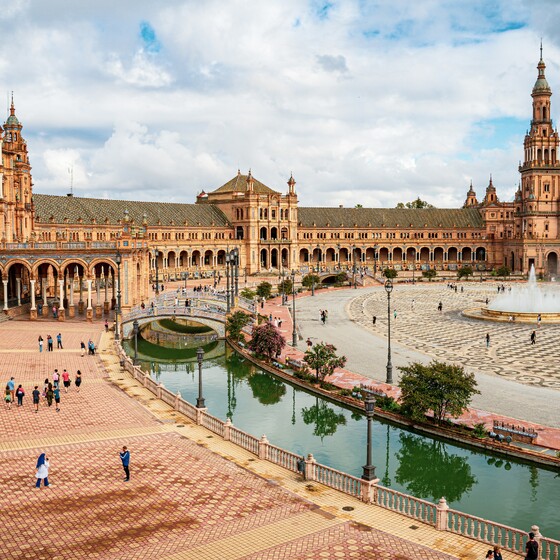
Plaza de España
The Plaza de España is one of Seville's most impressive buildings and a masterpiece of regional architecture. The semi-circular square was built in 1929 for the Ibero-American Exhibition and impresses with its size and attention to detail. Surrounded by a canal over which four bridges cross, the square symbolizes the four ancient kingdoms of Spain. The impressive mosaics along the walls represent the 48 Spanish provinces. Visitors can stroll through the arcades, take a boat trip on the canal or simply enjoy the impressive backdrop.

Seville Cathedral and La Giralda
The cathedral of Seville is not only the largest Gothic cathedral in the world, but also one of the most magnificent examples of the fusion of different architectural styles. The cathedral houses the tomb of Christopher Columbus and impresses with its majestic interior, which is rich in art treasures and historical relics. Right next to the cathedral is the Giralda, the former minaret tower of the mosque that once stood on this site. The Giralda offers a breathtaking view over the city and is an unmissable highlight for any visitor to Seville.
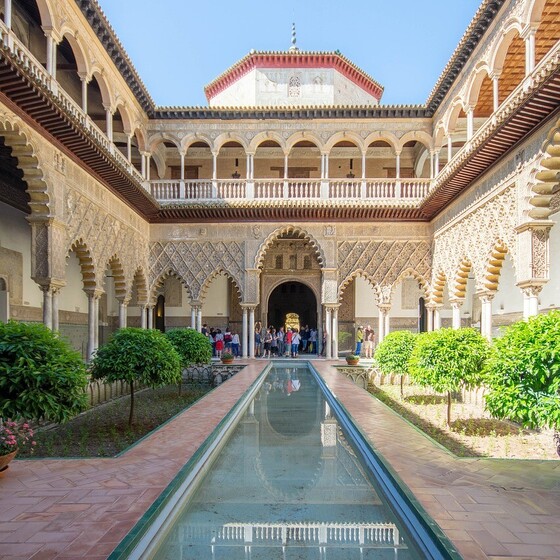
Real Alcázar
The Real Alcázar of Seville is another highlight that reflects the city's rich history. Originally built as a Moorish palace, the Alcázar was extended and renovated by Christian kings over the centuries. The result is a fascinating example of the Mudejar style, which combines Islamic and Christian architectural elements. The palace and its extensive gardens are a place of overwhelming beauty and a must-see for any traveler to Seville.
Marbella - Admire the yachts of the rich and famous
Marbella is an elegant seaside resort on the Costa del Sol. Tourists flock to Marbella - especially the rich. Because luxury abounds here. In and around Marbella you will find enchanting sandy beaches, villas, hotels and golf courses. Marbella is known for its famous Golden Mile (Avenida del Mar) with expensive stores, nightclubs and exclusive properties. The Golden Mile leads directly to the Puerto Banús marina. It is teeming with classy boutiques, bars and luxury yachts. Sit down, eat an ice cream and watch.
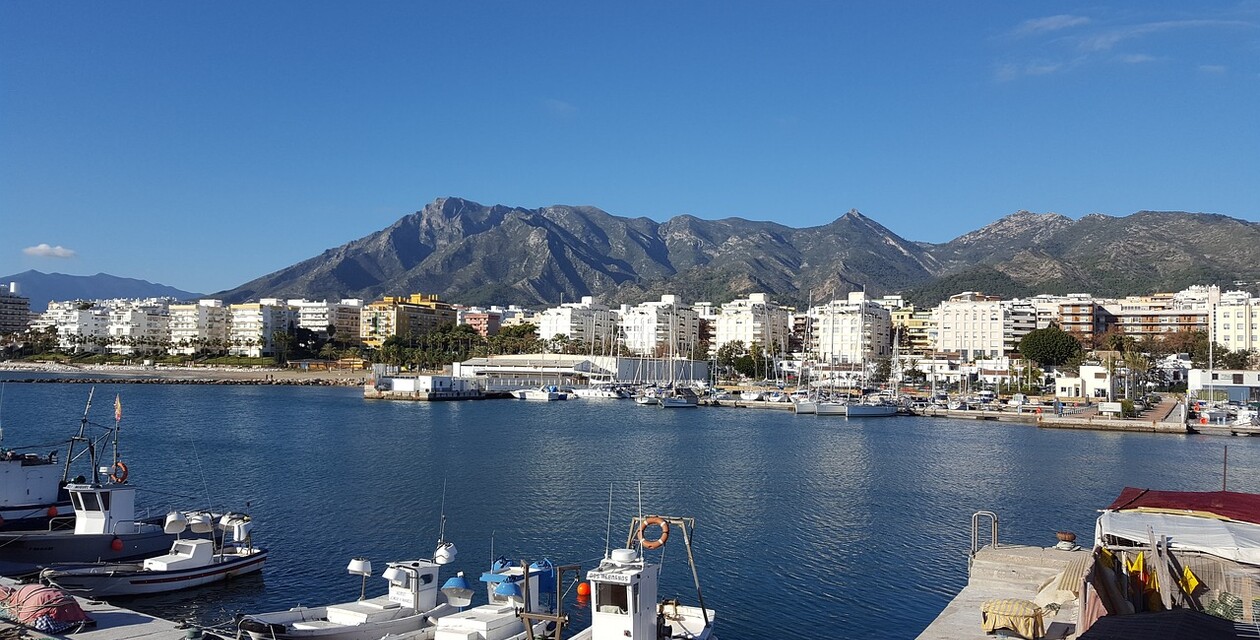
Malaga
Christian Andersen had already fallen in love with Malaga: "In no other Spanish city have I felt as happy and as comfortable as in Malaga", wrote the Danish author. We can understand that. Malaga is sunny, hospitable and full of life. It's easy to strike up a conversation here. If you want culture, simply explore the beautiful sights. There are endless churches and cathedrals here! Or enjoy the fragrant orange trees and seas of flowers in Pedo Luis Alonso Park. Marvel at the architecture of the famous Santa Iglesia Catedral Basîlica de la Encarnación (La Manquita for short) or the view over the city from the old fortress, the famous Alcazaba - definitely the most famous sight in Malaga. Next door is the Gibralfaro Castle. From there you have a fantastic view of the old Roman theater
Tip from Campfee Eva: Eva is from Malaga and recommends eating out at the port. There are numerous restaurants and bars with sea views here. A-Frame surf instructor Manolo, on the other hand, is enthusiastic about the Picasso Museum. After all, Pablo Picasso was born in Malaga.
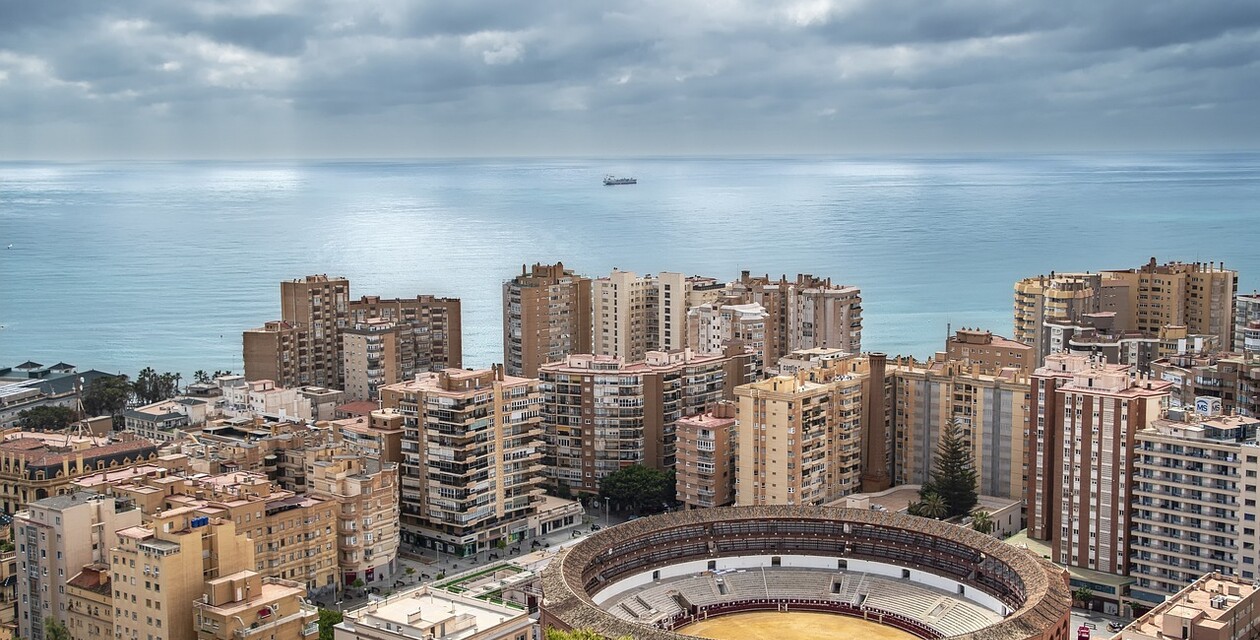
Gibraltar - Monkey watching in Great Britain?
One time to Great Britain please. Gibraltar lies between Spain and Morocco and has belonged to Great Britain for 300 years. Of course, there is a lot of controversy about this attractive piece of land. But we'll leave that aside here. What is exciting about Gibraltar for visitors? Clearly the Monkey Rock! It is located in the Upper Rock nature reserve. Around 300 wild Barbary macaques live here, incidentally the only free-living monkeys in Europe. The animals are not only popular, they are also quite cheeky. Tip: Hold on to your sunglasses when you're there. But Gibraltar is exciting in other ways too. Because there is no British bad weather here, but many other things you know from England: red double-decker buses, telephone and post boxes and the (Gibraltar) pound.
Our tip: There is no VAT in Gibraltar and is therefore considered a shopping paradise.
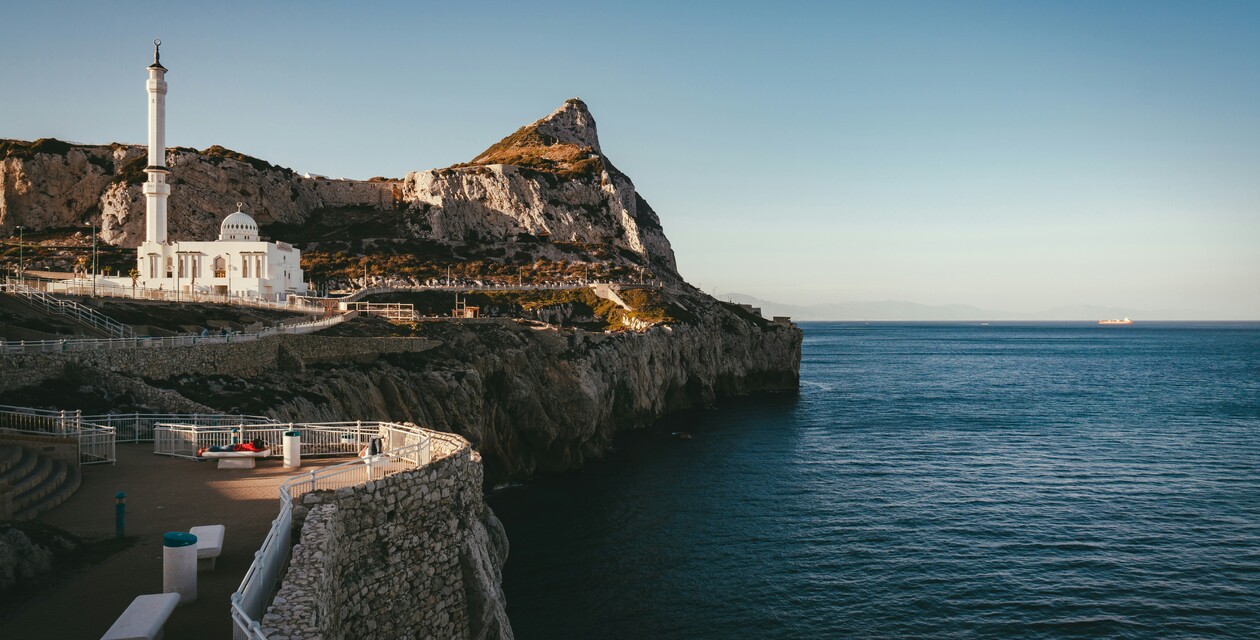
Tarifa - drinking coffee at the southernmost point of Europe
Tarifa is particularly popular with windsurfers and kitesurfers as there are great spots with plenty of wind all year round. In Tarifa, however, you can also stroll through the alleyways of the old town or browse through the numerous surf stores as a normal visitor. Tarifa is the southernmost point in Europe and only 14 kilometers from Africa as the crow flies. On nice days, you can see the Reef Mountains in Morocco from Tarifa. Fancy a trip to Morocco? Ferries cross over to Tangier several times a day. You can be in Africa in just 40 minutes from Tarifa. Numerous whale watching tours also depart from Tarifa (from March 23 to the beginning of November). Dolphins, pilot whales and fin whales can be found in the Strait of Gibraltar all year round. There are also sperm whales in spring and fall and orcas in July/August. At firmm there's even a 10% discount for our A-Frame guests. It's best to book by phone on (0034) 956 627 008. All staff speak German, English and Spanish. In the blog post about Tarifa we give you even more tips.
Tip from our team: Café El Tumbao is located in Tarifa, right on the beach. The best tapas can be found in the El Frances bar. You will find free parking on Calle Turriano Gracil.
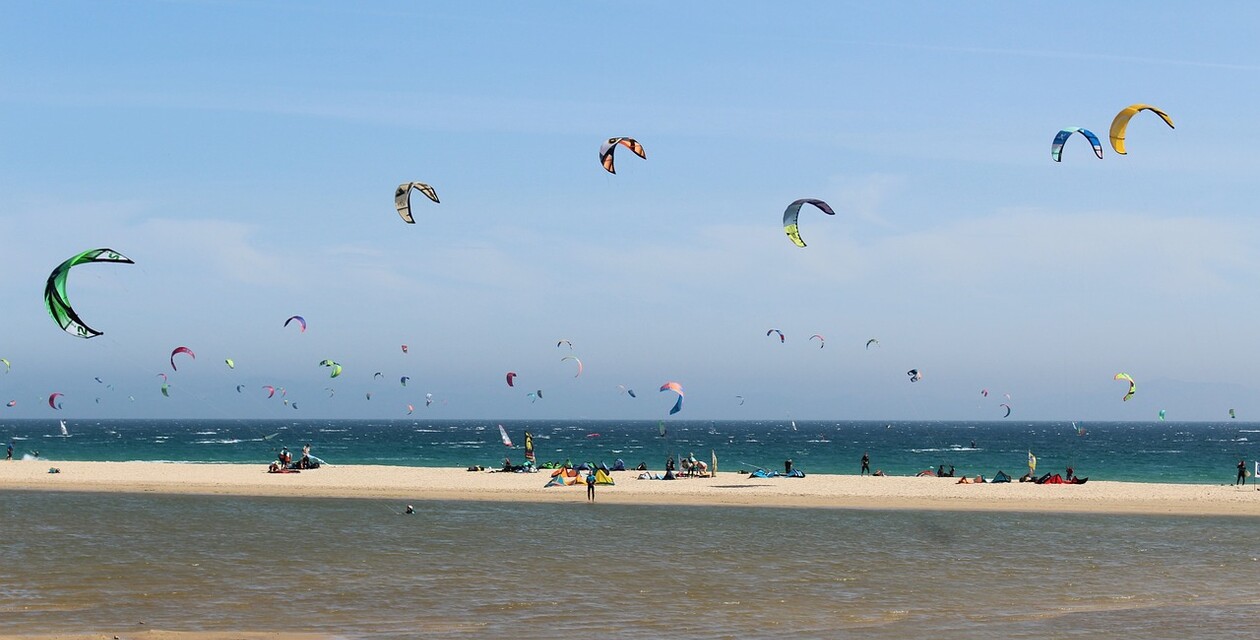
Cádiz - Cuban flair meets James Bond
Cadiz is considered the oldest city in Europe and is only 45 minutes by car from El Palmar. Cadiz is the capital of the province of the same name and is an old seafaring town. It has a harbor, ships, small pubs, restaurants, its own beach - everything you would expect from a seafaring town. Incidentally, Cadiz's twin city is Cuba's capital Havana - and the similarities between the two cities are astonishing. So much so that the James Bond film "Die Another Day" (partly set in Cuba) was filmed in Cadiz instead of Havana. Cool, right?
Tip: If you are planning your Andalusia vacation in February, you should not miss the famous carnival in Cadiz. During this time, the city is out of control and is only surpassed in its craziness by Rio de Janero and Trinidad.
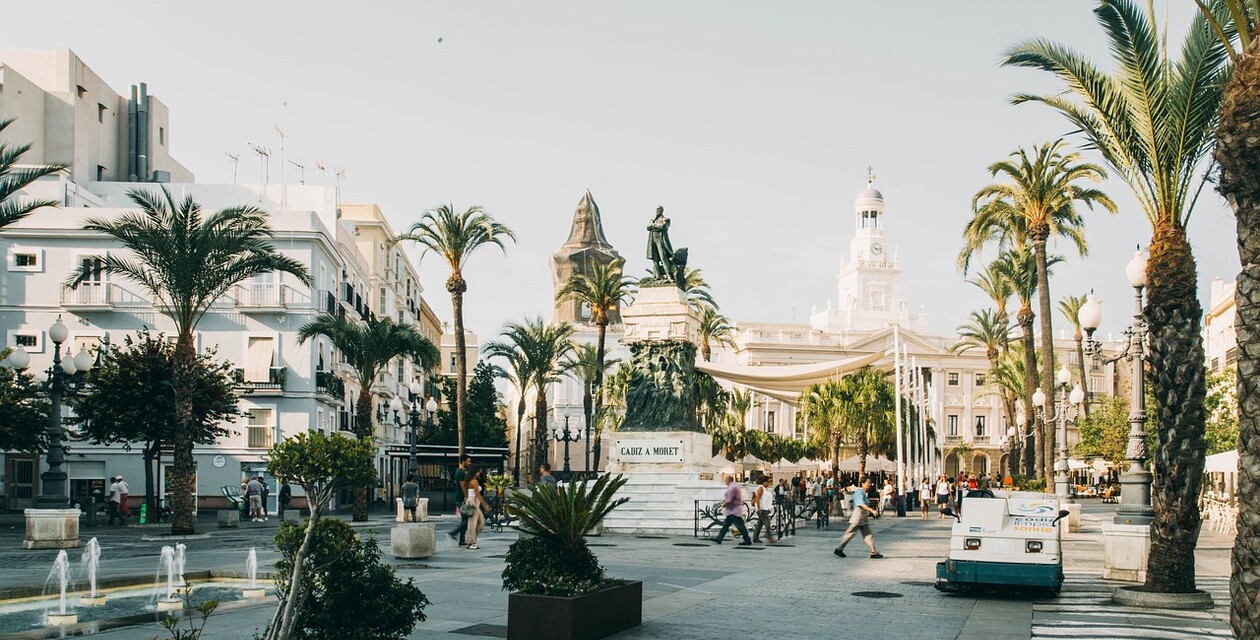
Córdoba
If you want to see sights in Andalusia, Córdoba is a must. The city is almost bursting at the seams with sights. Córdoba is so beautiful that the entire old town has been declared a UNESCO World Heritage Site. Roman bridges, oriental mosques and Spanish architecture turn Córdoba into a cultural melting pot. Here you can explore to your heart's content and you will not be disappointed. The Mezquita is particularly famous. After the Alhambra, it is the most important sight in Andalusia. The special thing about it: The Mezquita was actually once a mosque and was later converted into a cathedral. So you can look forward to a fantastic mix of two religions - in one building.
Tip: Monday to Saturday from 8:30 - 9:30 am, admission to the Mezquita is free.
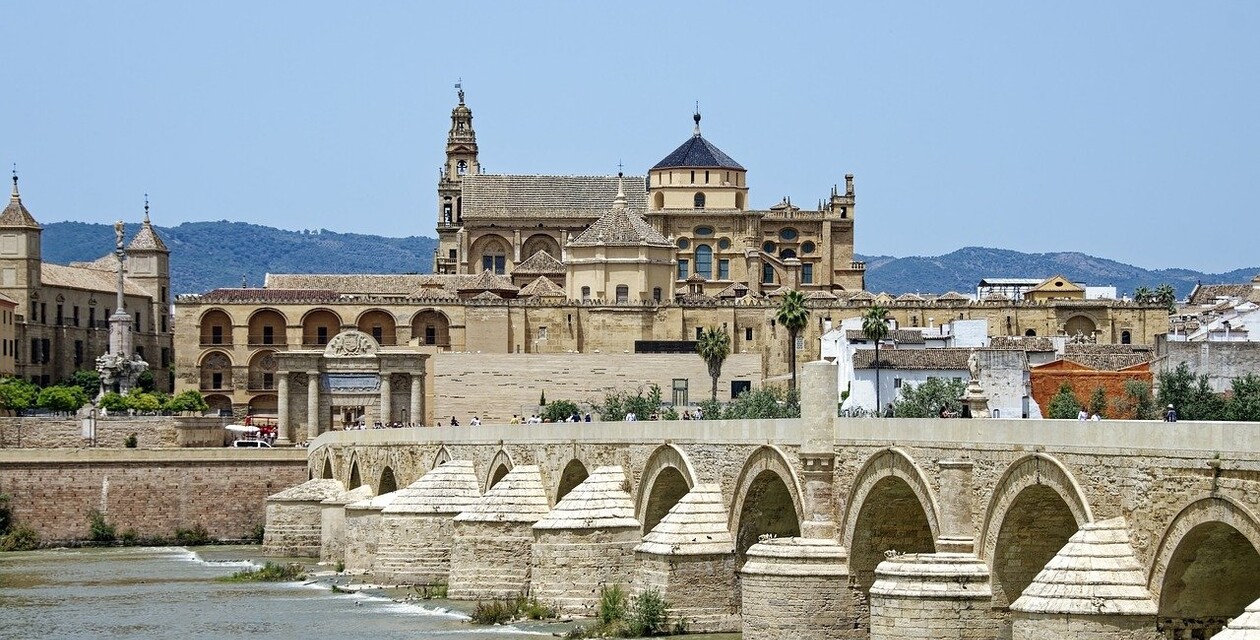
Granada
Granada is around 3.5 hours away from El Palmar. Nowhere else can you explore the Andalusian-Moorish culture in such diversity. Granada is best known for the famous Alhambra (see above), but there is much more to discover. For example, you can visit El Banuelo, an old Arab bath. Those who prefer to be outside should stroll around the beautiful Generalife. This was once the summer palace of the Moorish rulers and is also the oldest surviving Moorish garden complex. After a siesta, you can let yourself drift through Albaicin. In this lively district, you will find artisan workshops and typical Andalusian courtyards with a gallery and decorated all over with flower pots. The walls are often overgrown with bougainvillea and the whole district gives the impression of a small paradise.
Tip: Campfee Ana grew up in Granada and knows the city like the back of her hand. Her favorite thing to do is stroll along Calle Elvira and make a stop at the Babel World Fusion bar. It serves delicious international tapas. If you walk further up the street, you will come to a beautiful viewpoint with a view of the Alhambra, artists and flamenco dancers. It is most beautiful here at sunset. On the way up, you should definitely try a Moroccan tea and grapes with chocolate.
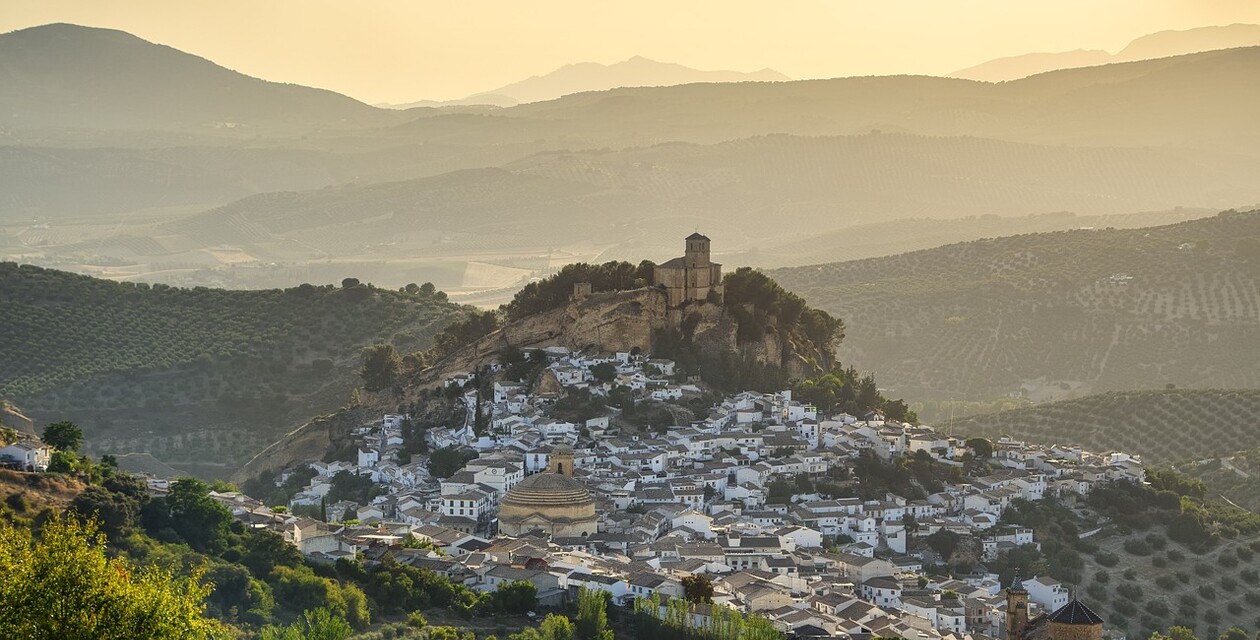

Granada tip: The Alhambra
You should definitely visit the Alhambra when you are in Granada! The Moorish fortress is located on the Sabikah hill in Granada. The Alhambra is the best-preserved example of the Moorish style within Islamic architecture and art. Its name comes from the Arabic and means "the red one". An allusion to the red color of the walls.
Extra tip: It's best to order your tickets online in advance. You will then receive a timeslot for your visit.
The White Villages: Charming jewels in Andalusia
The white villages of Andalusia, known as Pueblos Blancos, are an essential part of Andalusian culture and history. These villages are scattered throughout the picturesque mountainous landscapes of the hinterland and offer a breathtaking backdrop of whitewashed houses, narrow streets and impressive views. Each village has its own charm and history, deeply rooted in its Moorish past. Here are three of the most famous and beautiful white villages that you should definitely visit on your trip through Andalusia: Ronda, Zahara de la Sierra and Setenil de las Bodegas. Close to our surf camp, you will also find the extremely charming Vejer de la Frontera and Conil de la Frontera, which is beautifully located right by the sea.
Conil de la Frontera
Conil is only a five-minute drive away from El Palmar, also right by the sea. If you like walking, you can take a walk along the beach to Conil (approx. 45 minutes). Conil used to be a fishing village, but has now grown and attracts many tourists. Here you will find many small boutiques (including surf stores), ice cream parlors, tapas bars and restaurants. The region's famous white facades and the old church, Paroqueria de Sta. Catalina, are particularly pretty. From this square, you can not only see the beautiful building, but also the sea and magnificent palm trees. For more tips on Conil we recommend our blog post about Conil de la Frontera.
Tip from A-Frame Campfee Ana and surf head coach Daniel: The pastisserie, Canela & Miel, is the best place for home-baked cakes and tarts in Conil.
Vejer de la Frontera
If you love white houses, narrow streets and Moroccan food, you should put Vejer de la Frontera on your to-do list for your vacation in Spain. And right at the top. Vejer welcomes you with a bright white smile - or bright white house facades. In Vejer there are not only white houses but also an old city wall, beautiful flowers and everything is pretty. No wonder Vejer de la Frontera was voted the most beautiful Spanish village. The Andalusian village sits proudly and dreamily on top of the hill, seemingly just waiting to be explored. You can lose yourself in the beautiful alleyways all day long. If a door is open, risk a polite glance. The courtyards are usually beautifully planted and the entrances to the houses are covered with colorful tiles. Other highlights include sights such as the Iglesia del Divino Salvador, the Chapel of Nuestra Señora de la Oliva and the Castillo de Vejer. Delicious Moroccan food can be found at El Jardin de Califa. You can even sit outside here. The beautifully planted courtyard quickly transports you to Morocco. There is even a barbecue. Vegetarians will be delighted: you are spoilt for choice here.
You can read even more tips about Vejer in the blog post about Vejer de la Frontera.
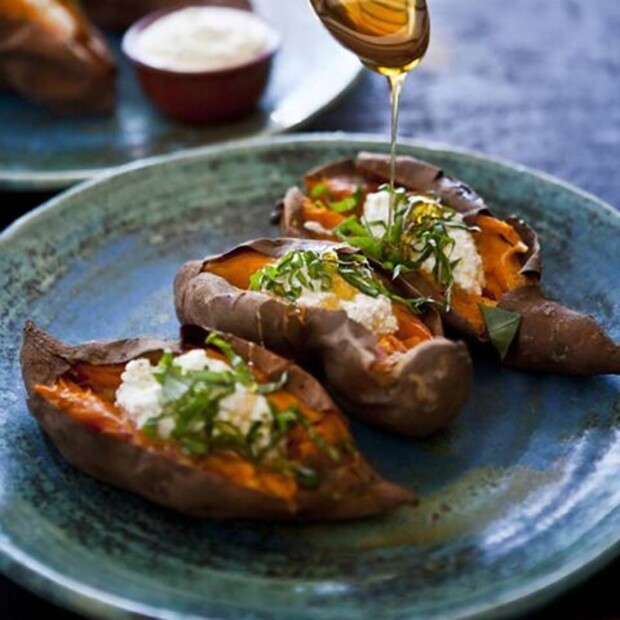
Restaurant tip near Vejer
Secret tip from the A-Frame Camp owners, Katrin and Arne: Food that makes you happy. At Restaurant Patria only fresh, seasonal and regional products are served. The restaurant has been run by a Danish couple from Copenhagen for ten years. The food is lovingly prepared and the wine tastes excellent. From the terrace you have a wonderful view over the surrounding countryside. Beautiful for dreaming. The gigantic lunch buffet is particularly popular. Guests even come from Seville or Malaga for it
Ronda
Ronda is probably the most famous of the White Villages in Andalusia. Ronda is located on a high plateau and is more than impressive. Famous writers such as Ernest Hemingway and Rainer Maria Rilke loved Ronda and appreciated its beauty. There are many old palaces and other historical buildings in Ronda. However, Ronda is most famous for its bridge, the Puente Nuevo, which over the 160 m deep gorge El Tajo connects the old and new town.
Tip from Campfee Tinka: Climbing tour with a view of the famous bridge. Aventuras Proema offers great tours. The provider also offers guided hikes, kayak tours, rafting and horseback riding. The tours are in Spanish.
Zahara de la Sierra
Castle and panoramic views
Zahara de la Sierra is a picturesque village perched high on a hill and overlooked by an imposing Moorish castle. The castle, which dates back to the 13th century, offers breathtaking panoramic views of the surrounding countryside, including the turquoise reservoir and the rolling hills of the Sierra de Grazalema. The climb up to the castle is a little strenuous, but the view is worth every effort. The whitewashed houses of the village, which stretch up the hill, give Zahara a special charm and make it one of the most beautiful villages in Andalusia.
Hikes in the Sierra de Grazalema
Zahara de la Sierra is also an ideal starting point for hikes in the Sierra de Grazalema, one of the most impressive natural parks in Andalusia. The park is known for its diverse flora and fauna, including the rare Pinsapo fir tree, as well as its spectacular karst landscapes and deep gorges. Numerous hiking trails lead through this breathtaking landscape, including the famous "Garganta Verde", a hiking trail that leads to a spectacular gorge and an impressive stalactite cave.
Setenil de las Bodegas
Unique architecture of houses built into the rocks
Setenil de las Bodegas is one of the most unusual and fascinating villages in Andalusia, known for its houses built into the rocks. This unique architecture was born out of the need to use the natural rock formations as protection from the heat and as additional living space. The houses of Setenil de las Bodegas are partially or completely carved into the rock, giving the village a distinctive appearance. The streets "Calle Cuevas del Sol" and "Calle Cuevas de la Sombra" are particularly impressive, where the rocks tower over the houses and streets, creating an almost surreal atmosphere.
Cultural highlights off the beaten track
Andalusia is not only known for its world-famous sights such as the Alhambra in Granada or the cathedral in Seville, but also for a multitude of cultural highlights that are often off the beaten track. These places and traditions offer a deeper insight into the rich history and vibrant culture of the region and are a must for anyone who wants to experience authentic Andalusia.
Festivals and traditions
Feria de Abril in Seville
The Feria de Abril is one of the most important festivals in Seville and takes place two weeks after Easter. Originally founded as a cattle market, the festival has developed into one of the largest and most colorful folk festivals in Spain. For a whole week, a large area on the outskirts of the city is transformed into a sea of colorful lights, flamenco dresses and festively decorated floats. This is where the Sevillanos meet to dance, eat and party until the early hours of the morning. Although the feria is now world-famous, it remains a deeply rooted local festival that reflects the traditional Andalusian lifestyle.
Semana Santa: Holy Week in Andalusia
The Semana Santa, the Holy Week before Easter, is one of the most important religious and cultural events of the year in Andalusia. In cities such as Seville, Málaga and Granada in particular, the week is celebrated with impressive processions in which elaborately carved figures of saints are carried through the streets. Each procession is organized by brotherhoods that often maintain centuries-old traditions. The festive atmosphere, the music of the brass bands and the deeply felt spirituality make Semana Santa an unforgettable experience. Away from the well-known routes, there are also impressive processions in smaller towns and villages that are less touristy but just as impressive. It is also quite crowded in El Palmar during this time. If you like it quieter, we would recommend avoiding Semana Santa as a vacation week.

Historic places and ruins
Baelo Claudia: The Roman city on the Atlantic
Baelo Claudia, on the coast near Playa de Bolonia, is one of the best-preserved Roman cities in Spain. This ancient city, founded in the 2nd century BC, served as an important trading post and was known for the production of garum, a popular fish sauce in the Roman Empire. Today, visitors can explore the ruins of Baelo Claudia, including a theater, temples, thermal baths and a basilica. Its location directly on the Atlantic Ocean, overlooking the nearby beach, gives this historic site a special atmosphere that harmoniously combines history and nature.
Dolmens of Antequera: UNESCO World Heritage Site
The dolmens of Antequera are prehistoric megalithic tombs that are among the most important archaeological sites in Spain. These impressive monuments, which date back to the Neolithic period, were declared a UNESCO World Heritage Site in the 2010s. Particularly noteworthy are the dolmens of Menga and Viera, which impress with their size and the precision of their construction. The dolmens are not only a fascinating example of early architecture, but also a testimony to the spiritual culture of the first settlers in this region.
Unknown sights
The Medina Azahara near Córdoba
The Medina Azahara, also known as the "shining city", is located just a few kilometers west of Córdoba and was once the magnificent residential city of the Caliph of Córdoba. Built in the 10th century, the Medina Azahara was the political and administrative center of the caliphate. Today, the remains of this city, once a symbol of the power and prosperity of the Caliphate of Córdoba, are one of the most important archaeological sites in Spain. Visitors can explore the ruins of the palaces, mosques and gardens and immerse themselves in the life and culture of Islamic Spain.
Castle of Almodóvar del Río: a medieval experience
The castle of Almodóvar del Río, located around 30 kilometers southwest of Córdoba, is one of the most impressive fortresses in Andalusia. Originally built by the Moors in the 8th century, the castle has been extended and restored several times over the centuries. Today it sits majestically on a hill overlooking the Guadalquivir and offers spectacular views of the surrounding countryside. The castle is a perfect example of medieval defensive architecture and offers an insight into the history of the region. Thanks to its well-preserved walls, towers and courtyards, the castle is often used for film and television productions, including the famous series "Game of Thrones".
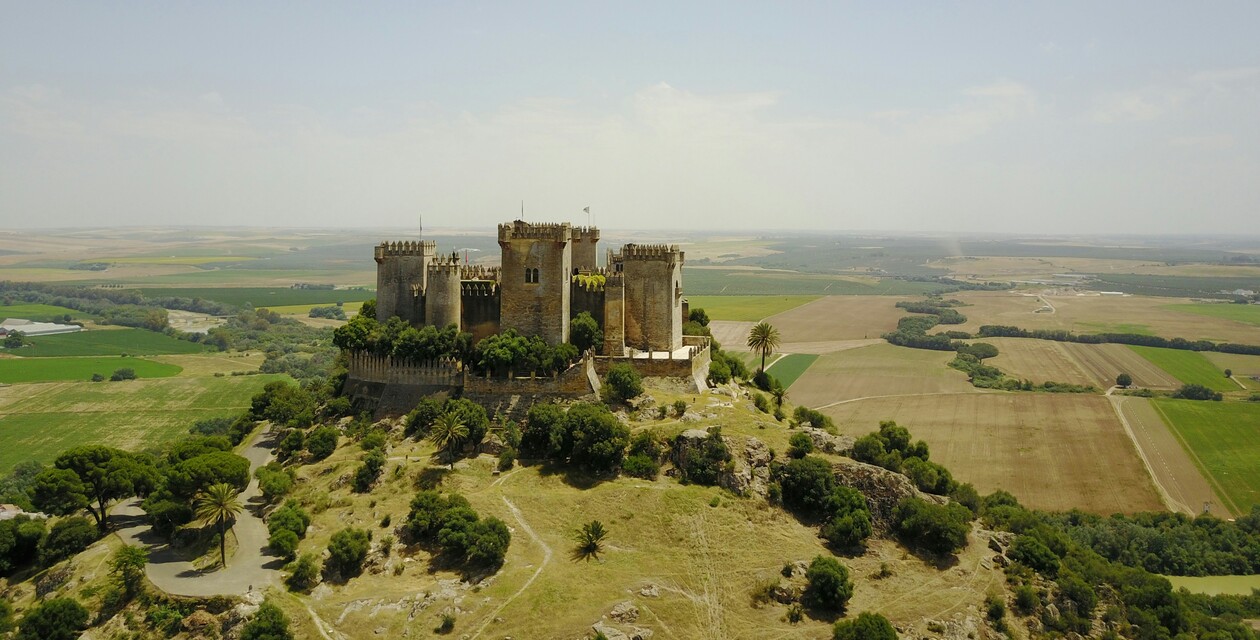
Andalusian gastronomy: culinary highlights
Andalusia is not only a feast for the eyes, but also for the palate. The region offers a rich culinary tradition characterized by a variety of influences from Arabic, Jewish and Mediterranean cuisine. From typical dishes such as tapas and gazpacho to the famous wines of Jerez, Andalusian gastronomy is an experience not to be missed. Here are some of the culinary highlights you can discover on your trip through Andalusia.
Typical dishes: tapas, gazpacho and pescaito frito
Tapas
Tapas are inextricably linked to Andalusian culture and are served in almost every bar and restaurant in the region. These small, varied dishes are the perfect way to discover the culinary diversity of Andalusia. Typical tapas include jamón ibérico (air-dried ham), tortilla española (Spanish omelette), albóndigas (meatballs in tomato sauce) and boquerones en vinagre (anchovies marinated in vinegar). Every city and region has its own variations and specialties, and eating tapas is not just a meal, but also a social experience.
Gazpacho
Gazpacho is a cold vegetable soup that is particularly refreshing on hot summer days. This traditional dish is made mainly from tomatoes, peppers, cucumber, garlic, olive oil and vinegar and is typical of the Andalusia region. It is a perfect example of Mediterranean cuisine that is healthy and light. In some versions, it is served with bread or in small glasses. A similar but lesser-known soup is the salmorejo from Córdoba, which is thicker and creamier than gazpacho and is often garnished with hard-boiled eggs and jamón.
Pescaito Frito
Andalusia is located on the Mediterranean and Atlantic, which is reflected in the abundance of fresh fish dishes. Pescaito frito is one of the region's best-known dishes and consists of small fish such as sardines, squid or anchovies that are dipped in flour and then deep-fried until crispy. This dish is often served in paper bags and sold on street stalls, especially in coastal towns such as Málaga or Cádiz. It is a simple but delicious dish that perfectly showcases the freshness of the sea.
Wine tours in Jerez: Sherry and its tradition
Jerez de la Frontera, a town in the province of Cádiz, is famous worldwide for its sherry production. The Sherry, a fortified white wine, has a centuries-old tradition here and is produced in different varieties, including the dry Fino, the sweet Pedro Ximénez and the nutty Amontillado. A wine tour in Jerez is a must for any wine lover, as it offers the opportunity to visit the bodegas (wineries), learn about the historical winemaking methods and, of course, taste the different types of sherry.
In the bodegas, visitors can also learn more about the solera method, a unique system of ageing used to produce sherry. The tours often also offer insights into sherry's connection to local culture, including its importance to Andalusian gastronomy and its role in festivals and celebrations.
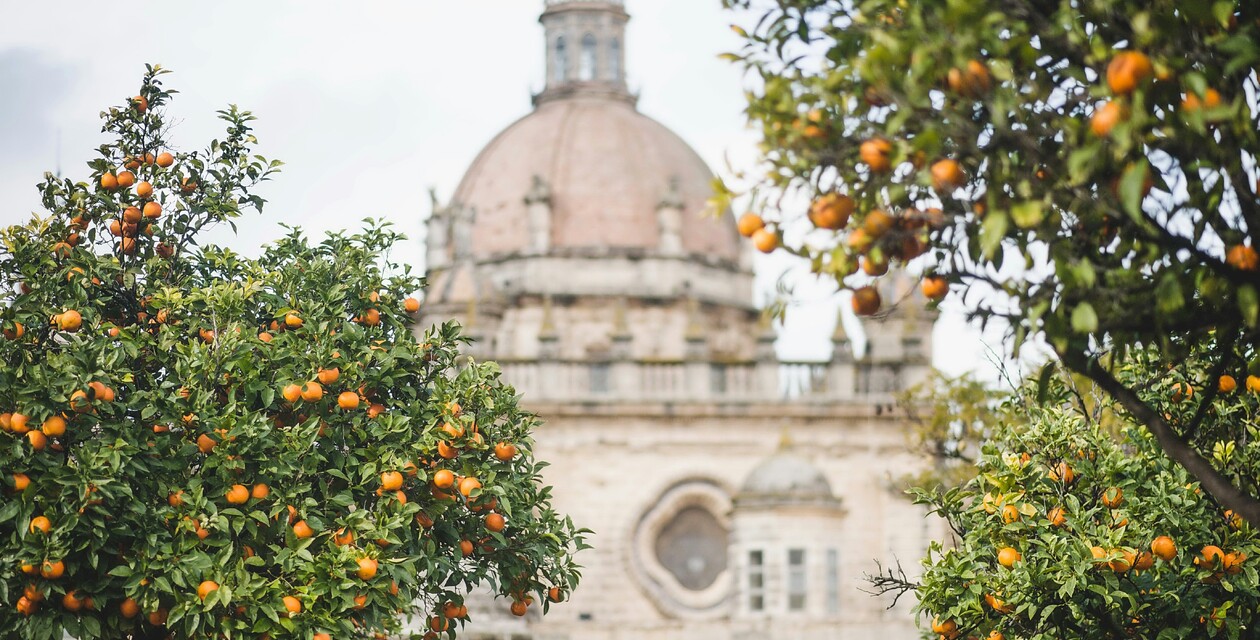
Special restaurants and markets in Seville, Málaga and Cádiz
Sevilla
Seville is home to some of the best restaurants in Andalusia, combining traditional cuisine with modern influences. A visit to the Mercado de Triana, one of the city's most famous markets, offers the opportunity to discover fresh regional produce, meat, fish and spices. Here you can be inspired by the diversity of Andalusian cuisine and try local specialties in one of the nearby restaurants, such as the famous El Rinconcillo, which is considered Seville's oldest tapas restaurant.
Málaga
Málaga is known for its lively gastronomic scene and offers both traditional and avant-garde cuisine. The Mercado de Atarazanas, a beautiful market in a historic building, is a paradise for foodies. Here you can sample fresh seafood, fruit, vegetables and local specialties from the stalls. Some of the best restaurants in Málaga, such as El Pimpi, combine Andalusian traditions with innovative dishes and an excellent selection of regional wines.
Cádiz
Cádiz, the oldest inhabited city in Western Europe, is famous for its fish dishes and the relaxed atmosphere of its restaurants and markets. The Mercado Central de Cádiz is a vibrant place where you can find the best fresh pescaito frito and other seafood. We particularly recommend a visit to Casa Manteca, a classic tavern known for its authentic atmosphere and delicious tapas.
Practical travel tips for Andalusia
Andalusia is one of the most diverse and fascinating regions in Spain. To make your trip as pleasant and smooth as possible, here are some practical travel tips.
Best time to travel to Andalusia
The best time to visit Andalusia depends on the planned activities and personal preferences. Generally speaking, the spring (April to June) and fall months (September to October) are ideal for visiting the region. During this time, the temperatures are pleasant, nature is in bloom or in autumnal colors and the sights are less crowded.
Spring: Spring is particularly beautiful as the temperatures are mild and the famous festivals such as the Feria de Abril in Seville and the Semana Santa take place.
Summer: The summer months (July and August) can get very hot, especially in the interior, where temperatures of over 40 degrees Celsius are not uncommon. However, the coastal areas offer a refreshing breeze and are ideal for a beach vacation. However, the beaches are quite crowded at this time.
Autumn: Autumn offers similar advantages to spring, with mild temperatures and fewer tourists.
Winter: Andalusia is also an attractive destination in winter, especially for city and cultural trips. The temperatures are mild, making it ideal for a warm winter escape. Those who like snow will find it in the Sierra Nevada. You can even go skiing here.
Transportation options: Car, train and bus
Andalusia is well connected and offers various transportation options for exploring the region:
Car: A rental car is the most flexible way to travel around Andalusia, especially if you want to visit the rural areas and smaller villages. The roads are generally well developed and the road network is extensive. However, parking can be difficult in the larger cities, especially in the historic centers.
Train: The train network in Andalusia is well developed and the cities are connected by fast and comfortable connections. The AVE high-speed train takes travelers quickly from Madrid to Seville, Córdoba or Málaga. Regional train connections are also reliable and a convenient option for longer distances.
Bus: Buses are a cost-effective alternative and also reach smaller towns that are not connected to the train network. The bus network is dense and buses run regularly. Companies such as ALSA offer connections between the main cities and tourist destinations.
Conclusion
Andalusia offers an impressive diversity that will delight any traveler, both culturally and scenically. With the right practical travel tips, such as choosing the best time to travel, using sustainable transportation options and being aware of safety and health, your stay in this fascinating region will be an unforgettable experience. Whether you want to explore historic towns, picturesque villages, beautiful beaches or the delicious Andalusian gastronomy - Andalusia has something for everyone.
The beach of El Palmar is a real insider tip, especially for surfers. This picturesque stretch of coastline offers excellent conditions for beginners and advanced surfers and is known for its relaxed atmosphere and closeness to nature. After a day on the waves, travelers can enjoy the local cuisine in the cosy chiringuitos and relax at the end of the day. With good planning and these valuable tips, nothing stands in the way of your perfect vacation in Andalusia.

